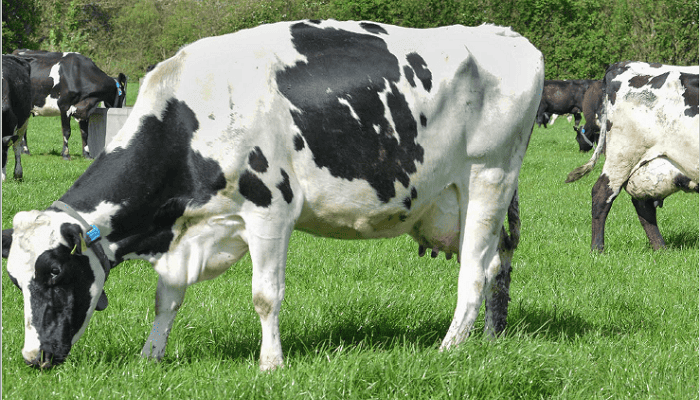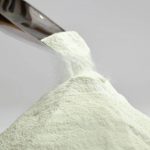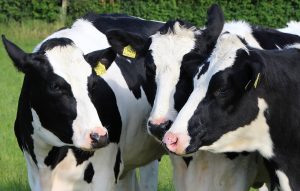
As the high rate of general inflation in Ireland over the last 18 months has eroded the real value of incomes on all farms and in the wider economy at large, delegates at today’s Moorepark Open Day in Fermoy, Co. Cork were reminded to refocus on financials to protect farm margin in 2023.
The greatest immediate challenge for Irish dairy farms is to secure an adequate household income for farm families against the backdrop of two consecutive years of agricultural input price hyperinflation (9% and 32% in 2021 and 2022, respectively).
In the below video, taken at the second board from today’s Moorepark Open Day, Padraig French focuses on three topics: how the profitability of dairy farms has evolved over the last number of years; what are the key performance indicators (KPIs) that are going to drive it to increase profitability over the next number of years; and a particular focus on stocking rate. Conor Hogan also joins Padraig to discuss sustainable labour input into our dairy farm systems.
Figure 1 illustrates the fluctuations in average gross margin, production costs and net profit margin (excluding family labour) during the last decade on Irish farms. Teagasc estimated that net margins on Irish dairy farms increased by 70% to €3.20 per kg fat plus protein (23.9 cent per litre) in 2022, and resulted in an average family farm income of €151,000 per farm (Teagasc, 2023). However, the strong performance of the sector in 2022 will not be repeated this year as milk prices have already reduced to 2021 levels.
Feed costs in particular, have remained at stubbornly high levels during 2023 (+75% of 2020 levels) and, together with rising interest rates, will likely contribute to a continuation of inflationary pressures and tightening cash flows on dairy farms for much of 2023.
On that basis, the average net margin per litre of milk is expected to fall to €1.50 per kg fat plus protein (12-14 cent per litre) in 2023. Hence, 2023 will be more typical of medium term norms, but it is essential for farmers to now create a financial budget to reappraise capital expenditure plans and maintain family farm income in this high cost environment.
To maintain profit margins, Irish dairy farmers must refocus on cost control during 2023. At a general level, multiple prices should be sought when sourcing farm materials during the remaining months of 2023 to take advantage of any market price reductions. More specifically, reduces feed costs as well as costs related to pasture and forage are an essential objective to constrain total production costs in 2023 as fertiliser prices reduce and increased use of clover in swards reduces total N fertiliser requirements.
Figure 1: Trends in gross output, costs and net profit margins on Irish dairy farms during the last decade (National Farm Survey) and forecasts for 2023
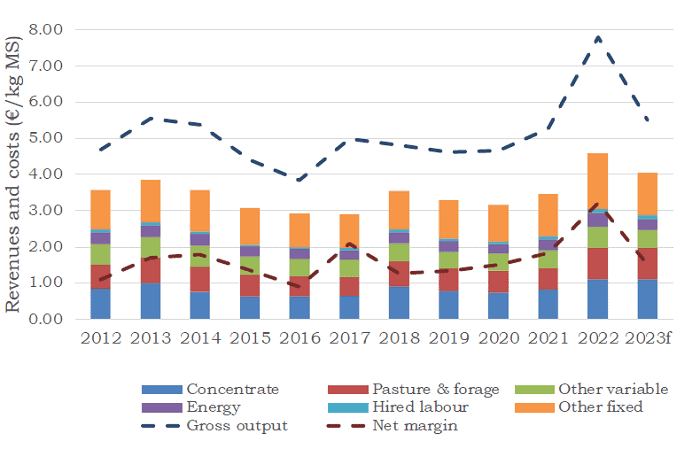
As purchased feed costs have markedly increased during the last decade through a combination of increased land costs, rising fertiliser prices and increased energy costs; the relative cost competitiveness of grazed pasture has been enhanced. Figure 2 outlines how absolute and relative feed costs have increased during the last decade. Grazed pasture and grass white clover have increased in cost by €30/t DM between 2013 and 2023, pit and bale silage have increased by €55 and €75/t DM during the same period and purchased concentrates have increased by €213/t DM. On a relative energy corrected basis, pit and bale silage are currently 2.5 times the cost of grazed pasture and purchased concentrate is five times the relative cost of grazed pasture.
Figure 2. Actual feed costs (€/tonne) during 2013 and 2023. [Adapted from Finneran et al., 2011, Doyle et al., 2023]
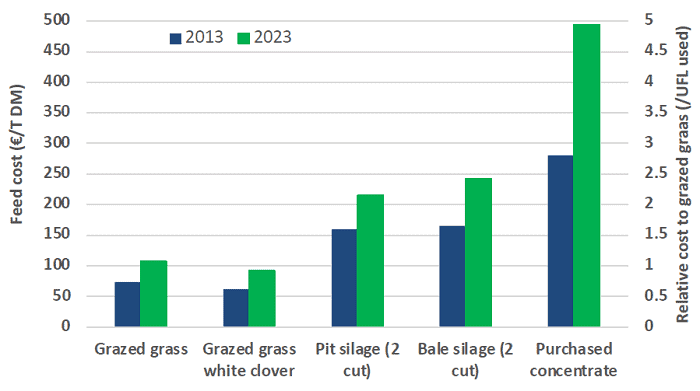
The central importance of increased pasture utilisation (t DM/ha) to increase economic performance in grazing systems is well recognised. Efficient pasture-based systems must therefore maintain a high proportion of grazed pasture in the animal diet to achieve a low production cost-base, and to insulate the dairy farm business from both climate and imported feed price shocks. An overall target of 70% grazed pasture in the dairy herd diet is appropriate in Irish grazing systems to achieve high levels of performance within a low cost grazing system. This equates to approximately 265 days of grazing and 0.5 tonnes of concentrate fed per lactating cow per annum.
This article was adapted from ‘Dairy systems – farming today with tomorrow in mind’ paper by Grainne Hurley, Conor Hogan, Padraig French and Brendan from the Teagasc Moorepark Open Day book. To access this book and for more information from the Moorepark Open Day, click here. https://www.teagasc.ie/corporate-events/moorepark-open-day/
